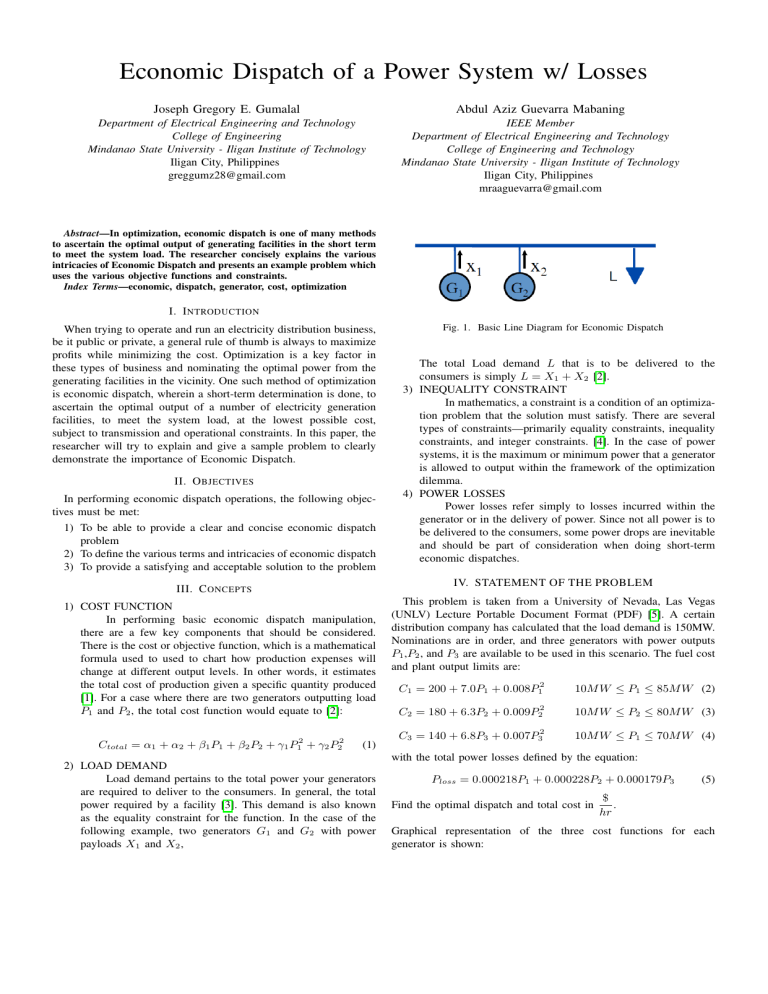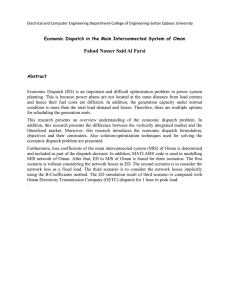
Economic Dispatch of a Power System w/ Losses Joseph Gregory E. Gumalal Abdul Aziz Guevarra Mabaning Department of Electrical Engineering and Technology College of Engineering Mindanao State University - Iligan Institute of Technology Iligan City, Philippines greggumz28@gmail.com IEEE Member Department of Electrical Engineering and Technology College of Engineering and Technology Mindanao State University - Iligan Institute of Technology Iligan City, Philippines mraaguevarra@gmail.com Abstract—In optimization, economic dispatch is one of many methods to ascertain the optimal output of generating facilities in the short term to meet the system load. The researcher concisely explains the various intricacies of Economic Dispatch and presents an example problem which uses the various objective functions and constraints. Index Terms—economic, dispatch, generator, cost, optimization I. I NTRODUCTION When trying to operate and run an electricity distribution business, be it public or private, a general rule of thumb is always to maximize profits while minimizing the cost. Optimization is a key factor in these types of business and nominating the optimal power from the generating facilities in the vicinity. One such method of optimization is economic dispatch, wherein a short-term determination is done, to ascertain the optimal output of a number of electricity generation facilities, to meet the system load, at the lowest possible cost, subject to transmission and operational constraints. In this paper, the researcher will try to explain and give a sample problem to clearly demonstrate the importance of Economic Dispatch. II. O BJECTIVES In performing economic dispatch operations, the following objectives must be met: 1) To be able to provide a clear and concise economic dispatch problem 2) To define the various terms and intricacies of economic dispatch 3) To provide a satisfying and acceptable solution to the problem The total Load demand L that is to be delivered to the consumers is simply L = X1 + X2 [2]. 3) INEQUALITY CONSTRAINT In mathematics, a constraint is a condition of an optimization problem that the solution must satisfy. There are several types of constraints—primarily equality constraints, inequality constraints, and integer constraints. [4]. In the case of power systems, it is the maximum or minimum power that a generator is allowed to output within the framework of the optimization dilemma. 4) POWER LOSSES Power losses refer simply to losses incurred within the generator or in the delivery of power. Since not all power is to be delivered to the consumers, some power drops are inevitable and should be part of consideration when doing short-term economic dispatches. IV. STATEMENT OF THE PROBLEM III. C ONCEPTS 1) COST FUNCTION In performing basic economic dispatch manipulation, there are a few key components that should be considered. There is the cost or objective function, which is a mathematical formula used to used to chart how production expenses will change at different output levels. In other words, it estimates the total cost of production given a specific quantity produced [1]. For a case where there are two generators outputting load P1 and P2 , the total cost function would equate to [2]: Ctotal = α1 + α2 + β1 P1 + β2 P2 + γ1 P12 + γ2 P22 Fig. 1. Basic Line Diagram for Economic Dispatch (1) 2) LOAD DEMAND Load demand pertains to the total power your generators are required to deliver to the consumers. In general, the total power required by a facility [3]. This demand is also known as the equality constraint for the function. In the case of the following example, two generators G1 and G2 with power payloads X1 and X2 , This problem is taken from a University of Nevada, Las Vegas (UNLV) Lecture Portable Document Format (PDF) [5]. A certain distribution company has calculated that the load demand is 150MW. Nominations are in order, and three generators with power outputs P1 ,P2 , and P3 are available to be used in this scenario. The fuel cost and plant output limits are: C1 = 200 + 7.0P1 + 0.008P12 10M W ≤ P1 ≤ 85M W (2) C2 = 180 + 6.3P2 + 0.009P22 10M W ≤ P2 ≤ 80M W (3) C3 = 140 + 6.8P3 + 0.007P32 10M W ≤ P1 ≤ 70M W (4) with the total power losses defined by the equation: Ploss = 0.000218P1 + 0.000228P2 + 0.000179P3 Find the optimal dispatch and total cost in (5) $ . hr Graphical representation of the three cost functions for each generator is shown: V. METHODOLOGY • Langrangian Function To tackle this type of economic dispatch problem, a Lagrangian function is formulated. The Lagrangian function is a technique that combines the function being optimized with functions describing the constraint or constraints into a single equation. Solving the Lagrangian function allows you to optimize the variable you choose, subject to the constraints you can’t change. In an ideal scenario where losses are neglected, the Lagrangian function is: ngen X L = Ctotal + λ Pdemand − Pi (6) i=1 where Ctotal is the sum total of all generator cost functions and Pdemand is the total load demand of the system that the generators are trying to power. In the case of losses being included, it is then added to the equation, thus becoming: Fig. 2. Generator 1 Cost Function Curve ngen X L = Ctotal + λ Pdemand + Ploss − Pi (7) i=1 • Condition for optimality By taking the derivative of the Langrangian function in terms of Pi and λ, we can surmise the following equations: dL = βi + 2γi Pi − λ dPi dL = dλ ngen Pdemand − X (8) Pi (9) i=1 rearranging and combining the equations to solve for λ, we now have the equation λ= Pngen Pdemand + i=1 Pngen 1 i=1 Fig. 3. Generator 2 Cost Function Curve • βi 2γi (10) 2γi Power Demand After solving for the Lagrange multiplier λ, the power for each generator can now then be solved by substituting λ to equation (8), equating itP to zero, and calculating for Pi . By ngen checking if Pdemand = i=1 Pi and that we are within the constraints, we can then confirm that the solution is correct. VI. RESULTS AND DISCUSSION Following the rules and directions in solving the economic dispatch for a three generator system with constraints and losses, we now have the values for the power output of the three generators, along with the losses associated with the problem. P1 = 31.94M W P2 = 67.278M W P3 = 50.8118M W Ploss = 29.8kW Fig. 4. Generator 3 Cost Function Curve Fortunately, the power output of the generators were within the constraints, thus not requiring further iterative calculations. VII. C ONCLUSION Economic dispatch is a very important tool in making informed and cost-effective decisions when it comes to meeting a load demand. However, in cases where the computed power exceeds beyond the constraints of the generator, high iteration calculations is not feasible by just using manual or handwritten solving. By employing the help of a program, most prominently used being MATLAB, we can lighten the workload by allowing the program to optimize and calculate efficiently. R EFERENCES [1] Anonymous, “What is a cost function?” online. [Online]. Available: https: //www.myaccountingcourse.com/accounting-dictionary/cost-function [2] A. A. G. Mabaning, “Introduction to Power System Economics,” EE 155, 2019. [3] Anonymous, “Load demand,” 1996. [Online]. Available: https://www.its. bldrdoc.gov/fs-1037/dir-011/ 1557.htm [4] ——, “What are constraints,” online. [Online]. Available: https: //en.wikipedia.org/wiki/Constraint (mathematics) [5] UNLV, “Economic dispatch,” pDF. [Online]. Available: http://www.egr. unlv.edu/∼eebag/Economic%20Generator%20Dispatch%20740.pdf


